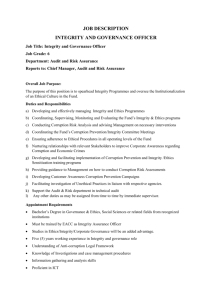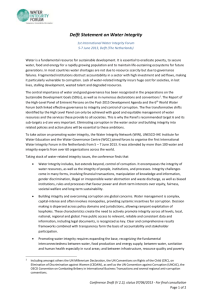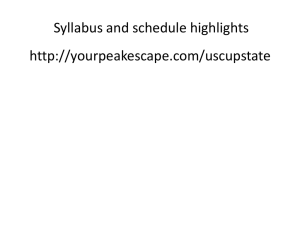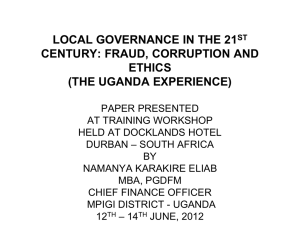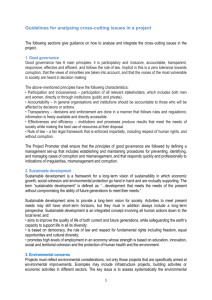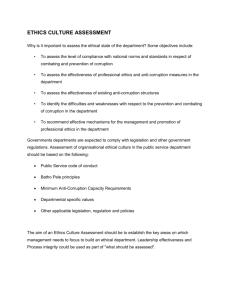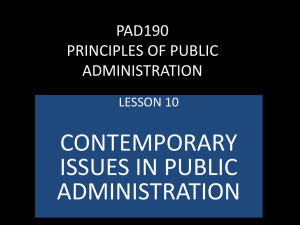Public Ethics and Accountability: Draft Proposal - Anti
advertisement
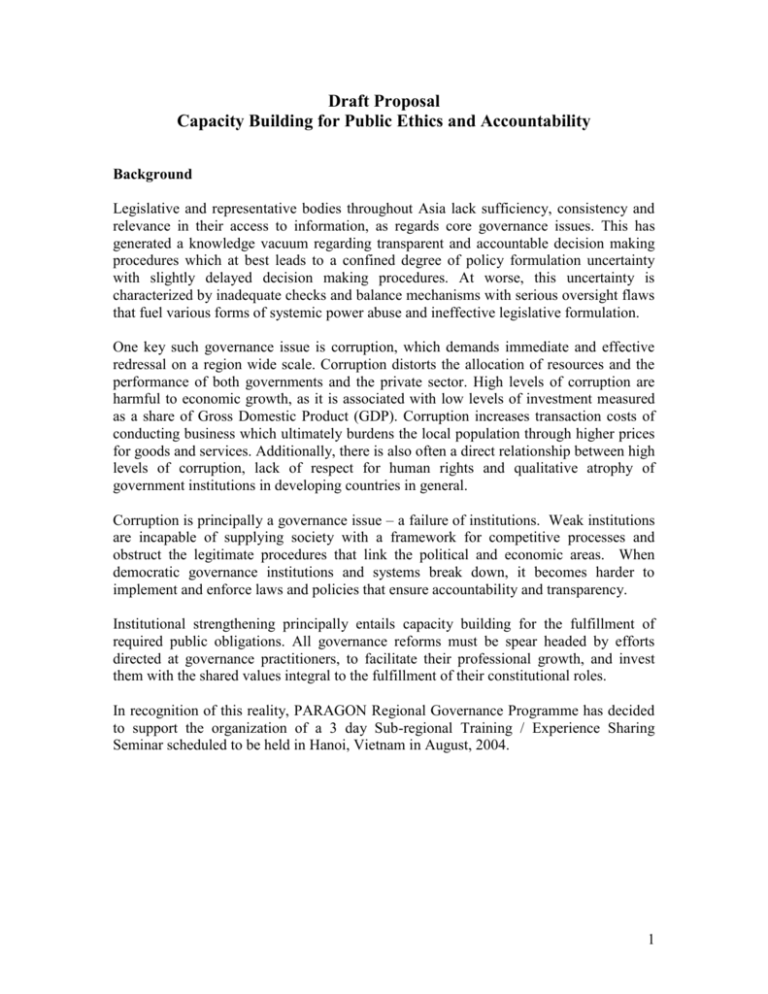
Draft Proposal Capacity Building for Public Ethics and Accountability Background Legislative and representative bodies throughout Asia lack sufficiency, consistency and relevance in their access to information, as regards core governance issues. This has generated a knowledge vacuum regarding transparent and accountable decision making procedures which at best leads to a confined degree of policy formulation uncertainty with slightly delayed decision making procedures. At worse, this uncertainty is characterized by inadequate checks and balance mechanisms with serious oversight flaws that fuel various forms of systemic power abuse and ineffective legislative formulation. One key such governance issue is corruption, which demands immediate and effective redressal on a region wide scale. Corruption distorts the allocation of resources and the performance of both governments and the private sector. High levels of corruption are harmful to economic growth, as it is associated with low levels of investment measured as a share of Gross Domestic Product (GDP). Corruption increases transaction costs of conducting business which ultimately burdens the local population through higher prices for goods and services. Additionally, there is also often a direct relationship between high levels of corruption, lack of respect for human rights and qualitative atrophy of government institutions in developing countries in general. Corruption is principally a governance issue – a failure of institutions. Weak institutions are incapable of supplying society with a framework for competitive processes and obstruct the legitimate procedures that link the political and economic areas. When democratic governance institutions and systems break down, it becomes harder to implement and enforce laws and policies that ensure accountability and transparency. Institutional strengthening principally entails capacity building for the fulfillment of required public obligations. All governance reforms must be spear headed by efforts directed at governance practitioners, to facilitate their professional growth, and invest them with the shared values integral to the fulfillment of their constitutional roles. In recognition of this reality, PARAGON Regional Governance Programme has decided to support the organization of a 3 day Sub-regional Training / Experience Sharing Seminar scheduled to be held in Hanoi, Vietnam in August, 2004. 1 Strategy and Procedure1 This sub-regional event will invite the participation of 6 delegates representing Cambodia, China, Laos PDR, and Vietnam respectively. In order to establish a standardised threshold for all participants it is proposed that: Each country would identify 6 delegates that will participate in the seminar. Each country delegation will thereafter be asked to prepare a Case Study on Country Specific Corruption, the guiding framework for which will be provided by MoHA and PARAGON. The curriculum, which ultimately will be determined by MoHA and PARAGON, would be based on a basic theoretical foundation derived from the PARAGON developed Public Sector Ethics and Accountability Training Module, to familiarize all participants with the fundaments of corruption, its causes, effects, countermeasures, and reduction of corruption in the workplace thereby establishing a harmonized level of understanding. Each country workgroup would then present a Case Study with lessons learnt, which would detail: A particular case illustration of the prevalence of corruption within their governance processes and structures of the respective countries A specific instance of corrupt practice and anti-corruption activities undertaken for its rectification The participants will then undergo an intensive brainstorming sessions in which suggested solutions to each country specific case are elaborated upon, incorporating suggestions from the entire group, to represent diverse points of view, innovative ideas, and allow for participation and joint ownership to foster bonds that may later be developed into formalized sub-regional networks. A number of innovative learning activities such as role playing, story telling, could also be utilized to simultaneously stimulate and strengthen personal linkages between participants, allowing them to simulate real world situations and hone specific skills for practical application. Objectives The principal goal of this initiative is to inculcate values of integrity, transparency and accountability into the context of the reality of the participating countries, through a combination of training, awareness raising, and experience sharing. Specifically, the purpose would be to: 1 For greater detail please refer to Annex 1. 2 Identify ethical issues of relevance to civil servants, affecting quality of service, customer relations, staff discipline, and efforts to counter corruption and minimize risks arising from the use of new technologies; Allow the cross fertilization of ideas, insights and experiences, both within and between national civil servant communities, for replication of successful initiatives, and avoidance of problematic measures; Understand the needs, patterns and tools for improving accountability work; Ascertain needful changes in the work culture of governmental departments, to bridge governance gaps in internal and external dealings; Evolve practical strategies to bring about those changes. Cultivate linkages, which may be formalized or institutionalized as a post-training follow-up under a sub-regional network structure. Expected Outcomes: Improved information dissemination / corruption related knowledge acquisition triggered through regional training sessions, which facilitate their replication on the national and local levels. Each trained pool of participants encouraged to further transfer newfound knowledge to advance learning within their respective offices / departments/ organizations. Consolidated regional sub-networks of governance reform practitioners, academicians, policy formulators, and civil servants Shifted policy focus of legislation to counteract corruption related flaws within the system. Continuous, long term and multi-faceted integrity improvements. Strengthened linkages between authority, responsibility and accountability. Clarification on the characteristics, and implications of corrupt behavior, engendering universally shared values across diverse religious beliefs, cultural norms, and societal mindsets. Activities: Solicitation of services of international consultants for the revision of the Public Sector Ethics and Accountability Training Module, part of the Governance Capacity Building Portfolio developed by United Nations Development Programme (UNDP)-PARAGON. Prepare and disseminate Terms of References for the country delegates that will attend the proposed seminar, as well as for the Case Studies that will be prepared and presented at that event. Organization of a Sub Regional Training Seminar in collaboration with the MoHA and the UNDP Hanoi CO, based on the revised Public Sector Ethics and Accountability Training Module, targeting civil servants from Cambodia, China, Lao PDR and Vietnam. 3 Continued provision of upstream policy analysis support to major governance policy and institutional reform processes underway in the region. Networking of government leaders, parliamentarians, civil society organizations, judicial officers, intellectuals, and the media at the national and sub-regional levels. 4 Annex 1 Tentative Programme of Activity for the three day Sub-Regional Training / Experience Sharing Seminar on Public Sector Ethics and Accountability Title of module / session Duration Objectives in minutes Day 1: Essential context building Session 1: Opening Session 60’ Session 2: Ethics and Action. What should we do? Why should we do it? Session 3: Accountability. To whom? For what? 90’ 90’ Key words on contents/activities Nature of the training activities Notes To welcome the participants to the workshop, and to introduce the participants to each other and to the trainers, through an ice breaking exercise: “The Fourfold Path”; To come to understand the expectations of the participants with regard to the workshop, and to respond to these if their expectations diverge too much from the objectives of the workshop; and To familiarize the participants with the background, objectives, content and schedule of the workshop and to talk about the training methodology employed during the course. Words of welcome, introduction to the course objectives and the programme, round of introductions and expectations from each participant, division of participants into 4 country specific Workgroups and dissemination of seminar materials. Interactive session with question and answer MS PowerPoint slides, as well as The Guide for Participants from the Public Sector Ethics and Accountability Training Module (PSEA) To consider foundations for ethics, and the applications in public service by: Seeking a universally pervasive ethic, that can be shared as a collective moral standard, so that culture can be discarded as an ‘excuse’ for corruption Resolving ethical dilemmas Mobilizing ourselves and staff towards the fulfillment of our roles Understanding linkages between ethics as a moral norm and ethics as a value based governance structure Discussion amongst facilitators and participants drawing on historical, religious, cultural, and political background provided by the curriculum, moving toward a range of inputs from participants based on their varied viewpoints, emerging with a shared standard of ethics, and mobilization of resources towards its implementation as the ethics of good governance. Focused interactive session MS PowerPoint slides, as well as The Guide for Participants from the PSEA Training module To understand the dimensions of accountability and evolve better accountability mechanisms by: Defining the accountability concept Defining the concept of accountability, informing participants of various accountability relationships, the watchdog Interactive lecture session (with guided discussion, question MS PowerPoint slides, as well as The Guide for Participants, facilitators and invited guests Culture, tradition, religion, ethics, dilemmas, governance. 5 How? Session 4: Corruption. Its description, consequences, patterns, and causes 90’ Day 1 Evaluation 15’ Understanding channels of accountability between organs of the State, within organs of the State, and between the State and the Public Identifying and analyzing the mechanisms that monitor the integrity of these relationships Realizing the realities and resolving the dilemmas arising from them e.g. More accountability would reduce corruption. Would it therefore lead to better service? Or would too much effort in ‘giving account’ decrease productivity? mechanisms which monitor them, and certain dilemmas emerging from difficult ground realities. and answer). Participants from the PSEA Training module Interactive lecture session, individual exercise, followed by plenary discussion MS PowerPoint slides, Questionnaires contained within the Guide for Participants, part of the PSEA Training module Accountability concepts, channels, mechanisms, and realities. To understand the damages wrought by corruption, its root causes, and evolve strategies for its elimination To analyze the various paradigms attached to corruption as a concept and as a practice by conducting an anonymous survey of perceptions and opinions amongst the participants concerning: For what would citizens expect to pay a bribe? Which public servant is considered most trustworthy? Results of the survey can be processed to gain a collective insight into national psyches, which can be analyzed further Recognizing corruption as a negative force, identifying its causes and effects, and evolving strategies to check its growth by understanding the thought processes, and general public opinions that sustain its stranglehold on governance institutions. To gauge whether the objectives of each session were fulfilled To gain feedback for improvements in content, delivery, logistical arrangements, learning techniques etc. Distribution of questionnaires to evaluate the training and learn of the participants’ impressions of the proceedings, which are collected so as to facilitate anonymous contribution. Corruption, causes, effects, perceptions and opinions. Surveys prepared beforehand. Feedback, evaluation, questions, queries, suggestions, comments. Day 2: Advanced Context Building and Presentations by Cambodia and China Workgroups Session 5: Managers. What are their roles? What are the tools at their disposal? 90’ To understand the responsibilities of the manager as incumbent in his role as anti-corruption change agent such as: Raising awareness, boosting morale, and strengthening motivation amongst staff and the general public Identify the managerial responsibilities for reducing corruption within their individual spheres of influence, by information dissemination and networking, systematic improvements, and operations geared towards making corruption an unfeasible Interactive lecture session (with guided discussion, question and answer) MS PowerPoint slides, The Guide for Participants from the PSEA Training 6 Session 6: Technology. Contemporary issues in Ethics and Accountability. 90’ Session 7: Presentation of the Cambodian Case Study on Country Specific Corruption. 90’ Improving systems for legislative reform, effective check and balance mechanisms, and accountable monitoring and compliance mechanisms Increasing the risks and decreasing the gains of corrupt practices To identify the tools and resources that can be employed in the fulfillment of these responsibilities option. To understand the changes brought by the advent of Information and Communications Technology as regards: Changing governance needs and priorities New responsibilities for policy makers and policy enforcers Increased complexity and uncertain decision making Increased risks to personal, financial, intellectual security at the local, national, and regional levels of governance To articulate strategies that ensure consistency and sustainability of ethical standards in the face of changing trends and increasing complexity Identify the impacts of Information and Communication Technology on governance processes and structures, and the various ethical dilemmas that could arise from increasing complexity of environmental dynamics. Develop methods of making ethical standards that withstand the technological revolution. To provide a background scenario of corruption levels within the public sector To describe a specific instance of corrupt practice and any rectifying actions taken by respective authorities To identify the roles of key stakeholders involved i.e. media, civil society, law enforcement, legislators, judiciary etc. To provoke dissent and discussion for the development of innovative solutions To enhance problem solving capabilities, learning capacities, and to enable perspectives to be shared Presentation of the Case Study by the workgroup followed by a brainstorming session for providing solutions to each problem based on the scenario in question. This will be followed by a role playing exercise where each member of the group assumes the position of one of the key stakeholders identified in the Case Study and acts out the described scenario. The solution arrived at through discussion amongst the participants is included in this scenario. The audience is encouraged to comment and question throughout the exercise. Managerial responsibilities, tools, informing, motivating, improving, seeking cooperation. Structured group discussion MS PowerPoint slides, The Guide for Participants from the PSEA Training Group exercise Case Study prepared beforehand by each group of delegates from their respective countries. Information, communication, technology, change, policy, ethical decision making Cambodian presentation, discussion, roleplaying, brainstorming. 7 Session 8: Presentation of the Chinese Case Study on Country Specific Corruption. 90’ To provide a background scenario of corruption levels within the public sector To describe a specific instance of corrupt practice and any rectifying actions taken by respective authorities To identify the roles of key stakeholders involved i.e. media, civil society, law enforcement, legislators, judiciary etc. To provoke dissent and discussion for the development of innovative solutions To enhance problem solving capabilities, learning capacities, and to enable perspectives to be shared Presentation of the Case Study by the workgroup followed by a brainstorming session for providing solutions to each problem based on the scenario in question. This will be followed by a role playing exercise where each member of the group assumes the position of one of the key stakeholders identified in the Case Study and acts out the described scenario. The solution arrived at through discussion amongst the participants is included in this scenario. The audience is encouraged to comment and question throughout the exercise. Group exercise Case Study prepared beforehand by each group of delegates from their respective countries. Chinese presentation, discussion, roleplaying, brainstorming. Day 2 Evaluation 15’ To gauge whether the objectives of each session were fulfilled To gain feedback for improvements in content, delivery, logistical arrangements, learning techniques etc. Distribution of questionnaires to evaluate the training and learn of the participants’ impressions of the proceedings, which are collected so as to facilitate anonymous contribution. Surveys prepared beforehand. Feedback, evaluation, questions, queries, suggestions, comments. Day 3: Presentations by the Laotian and Vietnamese Workgroups, Summation and Action Planning Session 9: Presentation of the Laotian Case Study on Country Specific Corruption. 90’ To provide a background scenario of corruption levels within the public sector To describe a specific instance of corrupt practice and any rectifying actions taken by respective authorities To identify the roles of key stakeholders involved i.e. media, civil society, law enforcement, legislators, judiciary etc. To provoke dissent and discussion for the development of innovative solutions To enhance problem solving capabilities, learning capacities, and to enable perspectives to be shared Presentation of the Case Study by the workgroup followed by a brainstorming session for providing solutions to each problem based on the scenario in question. This will be followed by a role playing exercise where each member of the group assumes the position of one of the key stakeholders identified in the Case Study and acts out the described scenario. The solution arrived at through discussion amongst the participants is included in this scenario. The audience is encouraged to comment and question throughout the exercise. Group exercise Case Study prepared beforehand by each group of delegates from their respective countries. 8 Laotian presentation, discussion, roleplaying, brainstorming. Session 10: Presentation of the Vietnamese Case Study on Country Specific Corruption. 90’ To provide a background scenario of corruption levels within the public sector To describe a specific instance of corrupt practice and any rectifying actions taken by respective authorities To identify the roles of key stakeholders involved i.e. media, civil society, law enforcement, legislators, judiciary etc. To provoke dissent and discussion for the development of innovative solutions To enhance problem solving capabilities, learning capacities, and to enable perspectives to be shared Presentation of the Case Study by the workgroup followed by a brainstorming session for providing solutions to each problem based on the scenario in question. This will be followed by a role playing exercise where each member of the group assumes the position of one of the key stakeholders identified in the Case Study and acts out the described scenario. The solution arrived at through discussion amongst the participants is included in this scenario. The audience is encouraged to comment and question throughout the exercise. Group exercise Case Study prepared beforehand by each group of delegates from their respective countries. Structured group discussion Country Specific Case Studies on Corruption, and previous session notes. Vietnamese presentation, discussion, roleplaying, brainstorming. Session 11: Synopsis. Comparison and Analysis of Country Experiences. 90’ To identify the differences and similarities amongst the 4 represented countries as regards the: Dynamics of policy and influence amongst institutional stakeholders Present level of corruption and the state of counter-corruption efforts ( Strengths, Weaknesses, Opportunities, and Threats, SWOT) To analyze the underlying causative factors behind these differences and similarities by using tools assembled from the context building exercises: Imprints of culture, society, religion and other indigenous factors Channels of accountability amongst governance processes and structures Causes and effects of corruption Responsibilities of managers and the tools at their disposal Impacts of technology and the sustainability of ethical standards in the wake of rapid Comparison of experiences from Lao PDR, China, Cambodia, and Vietnam, gleaned from Case Study presentations and ensuing group discussion. Analysis of the factors which shape the problems unique to each country, drawing on the theoretical insights gained in the first half of the course, allowing real-time application of knowledge and increased retentive power of new found learning. Comparison, similarities, differences, analysis of factors, analytical tools, application and retention. 9 technological change Session 12: Future Orientation. What next? 90’ Day 3 Evaluation 60’ To create realistic action plans for utilization of material in the workplace environment specifically: Promote ethics within the workplace culture To prevent corruption within the workplace environment To allow individual ownership of new found knowledge To ensure mushrooming of learning initiatives at the regional, national, and local levels Development of individual action plans by participants for immediate impact upon their return to real world environments. To gauge whether the objectives of each session were fulfilled To gain feedback for improvements in content, delivery, logistical arrangements, learning techniques etc. Distribution of questionnaires to evaluate the training and learn of the participants’ impressions of the proceedings, which are collected so as to facilitate anonymous contribution. Individual Exercise Action, impact, results, application of knowledge, replicate training initiatives. Surveys prepared beforehand. Feedback, evaluation, questions, queries, suggestions, comments. 10
